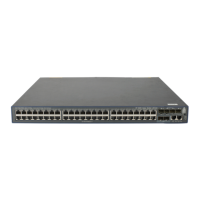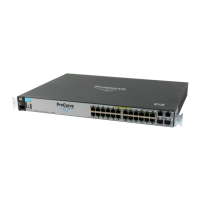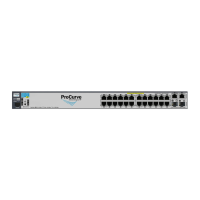223
3. Create an EBGP peer group.
group
group-name
external
By default, no EBGP peer groups
exist.
4. Create an IPv4 BGP peer
and specify its AS number.
peer
ipv4-address [ mask-length ]
as-number
as-number
By default, no IPv4 BGP peers
exist.
5. Add the peer into the EBGP
peer group.
peer
ipv4-address [ mask-length ]
group
group-name [
as-number
as-number ]
By default, no peers exist in the
peer group.
The
as-number
as-number
option, if used, must specify the
same AS number as the
peer
ipv4-address [ mask-length ]
as-number
as-number
command.
6. (Optional.) Configure a
description for the peer
group.
peer
group-name
description
text
By default, no description is
configured for the peer group.
7. Create the BGP IPv4 unicast
address family or BGP-VPN
IPv4 unicast address family
and enter its view.
address-family ipv4
[
unicast
]
By default, no BGP IPv4 unicast
address family or BGP-VPN IPv4
unicast address family exists.
8. Enable the router to
exchange IPv4 unicast
routing information with
peers in the specified peer
group.
peer
group-name
enable
By default, the router cannot
exchange IPv4 unicast routing
information with the peers.
To configure an EBGP peer group by using Method 2 (IPv6 unicast address family):
1. Enter system view.
system-view
N/A
2. Enter BGP instance view or
BGP-VPN instance view.
• Enter BGP instance view:
bgp as-number [ instance
instance-name ]
• Enter BGP-VPN instance
view:
a. bgp as-number
[ instance
instance-name ]
b. ip vpn-instance
N/A
3. Create an EBGP peer group.
group
group-name
external
By default, no EBGP peer groups
exist.
4. Create an IPv6 BGP peer
and specify its AS number.
peer
ipv6-address [ prefix-length ]
as-number
as-number
By default, no IPv6 BGP peers
exist.
5. Add the peer into the EBGP
peer group.
peer
ipv6-address [ prefix-length ]
group
group-name [
as-number
as-number ]
By default, no peers exist in the
peer group.
The
as-number
as-number
option, if used, must specify the
same AS number as the
peer
ipv4-address [ prefix-length ]
as-number
as-number
command.

